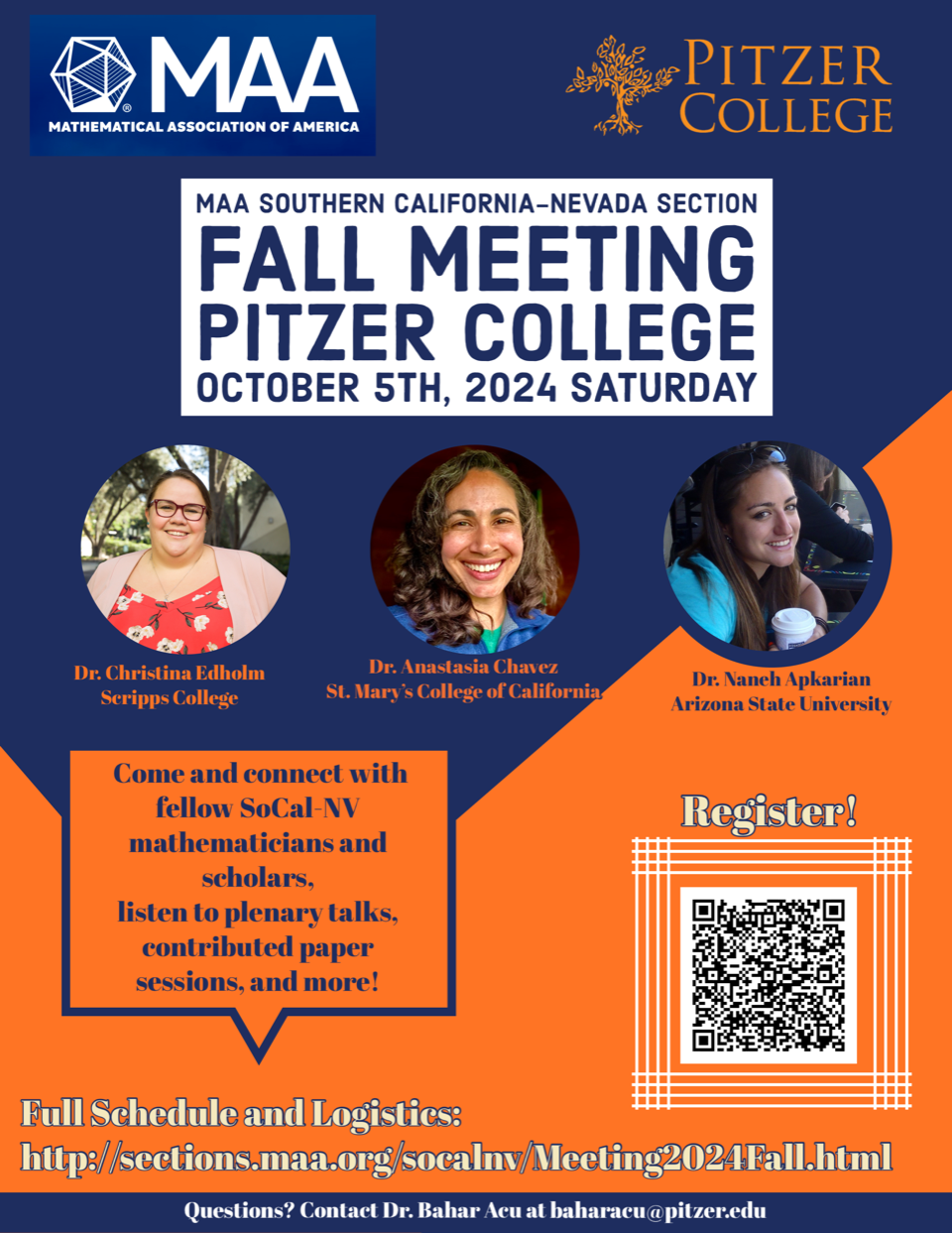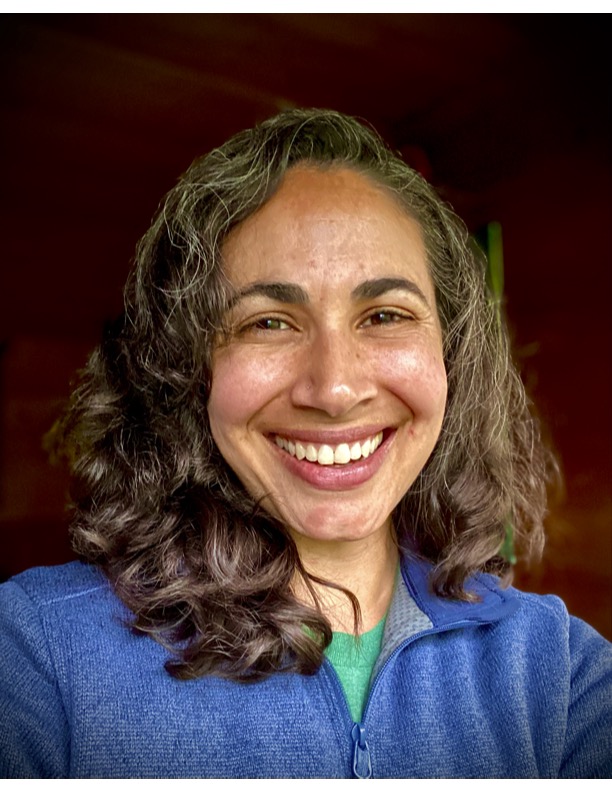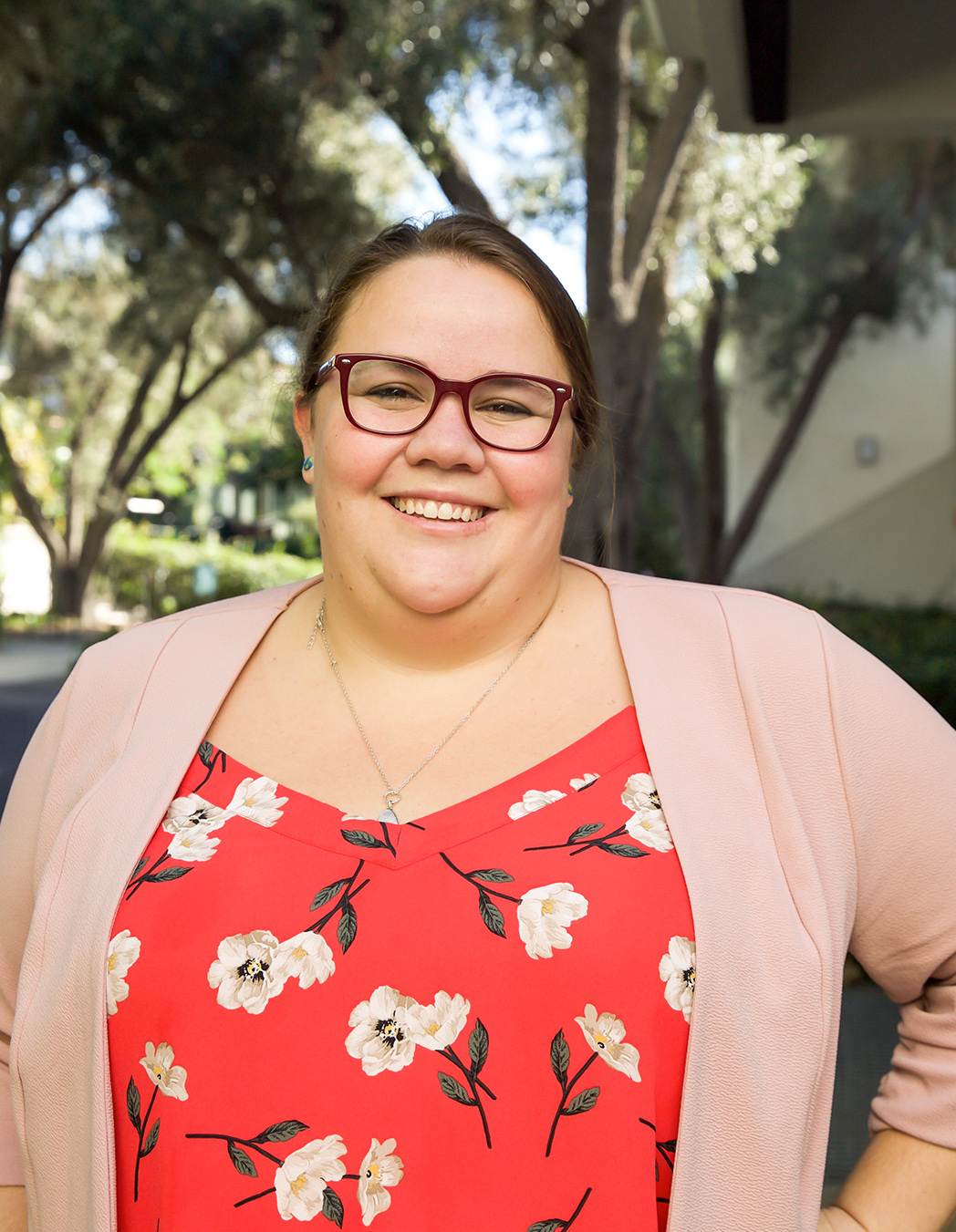Register
Registration will be opening soon.
Register online by paying with a credit card, paypal or google pay.
Online registration (no lunch option) closes Sat Oct 5 at 11:30am.
Fall 2024 SoCal-Nev Section Meeting
Pitzer College, Claremont CA
Saturday, October 5, 2024, 8:30am - 4:15pm
(Directions and Map)
Meeting Program
The pdf of meeting program (including Contributed Paper Session Schedule and Abstracts)
Meeting Poster
(png file)
Schedule
- 8:30-11:30 Registration
Benson Auditorium foyer - 9:00-9:05 Welcome Remarks
Benson Auditorium - 9:05-10:05 Invited Address by Christina Edholm, Scripps College
Utilizing Mathematical Modeling and Computation to Gain Insight into Epidemics
Benson Auditorium - 10:05-10:35 Section Business Meeting: for all section members and attendees
Benson Auditorium - 10:35-10:45 Break
- 10:45-12:30 Faculty and Student Contributed Paper Session
Benson Auditorium and Fletcher Hall 104, 106, 110, 112 - 12:30-1:45 Lunch
If you purchased a box lunch, it can be picked up in the foyer of Benson Auditorium. - 1:45-2:45 Invited Address by Naneh Apkarian, Arizona State University
Updating the Research on the Uptake of Research-Based Instructional Practices Post-COVID
Benson Auditorium - 2:45-2:50 Conference photo
- 2:50-3:00 Break
- 3:00-4:00 Invited Address by Anastasia Chavez, St. Mary's College of California
Matroids, Positroids, and Beyond!
Benson Auditorium - 4:00-4:15 Closing Remarks
Wi-Fi Access
Both the Eduroam and Claremont-WPA networks are available throughout Pitzer College and neighboring institutions for wireless internet access.
Eduroam enables users—including researchers, faculty, students, and staff—from participating institutions to securely connect to the internet using their institutional email accounts.
Pitzer users can log in using the following format:
Username: username@pitzer.edu
Password: Pitzer account password
Claremont-WPA is the preferred network among the Claremont Colleges, offering the highest level of security, stability, and speed.
Guests on campus can log in using the following credentials:
Network |
Claremont-WPA |
Username |
|
Password |
Claremont#1009$ |
Directions, Maps and Parking
Interactive Campus Map for Parking
Interactive Campus Maps and Driving Directions can be found on the Pitzer College Directions and Parking page.
The primary parking for the Section Meeting is the East Mesa Parking Lot which is free over the weekend. The East Mesa parking lot is the largest parking area on the Pitzer campus. The lot is accessible from E. Ninth Street; the nearest large cross street is Claremont Boulevard.
Altenatively, you can consider parking on the west end of the campus along Claremont Blvd or in the admissions or employee parking as needed.
We advise avoiding the neighboring campuses (CMC, Harvey Mudd, Pomona, and Scripps) for parking and/or clear signage for on-campus staff and faculty residents.Registration Information
All registrations, other than for poster presenters, will take place through Eventbrite.
Contributed Paper Presenters: Application deadline Fri September 20, at 5pm. Presenters need to register separately for the conference in addition to submitting an abstract. You must be registered to present.
Priority Registration+ Lunch option: register by Fri Sept 27 at 5pm for a lower registration rate, as well as a printed nametag and registration packet. Registering by the priority deadline enables you to add on a lunch to your order. It also minimizes stress and helps us have a more accurate catering count.
Online Pre-Registration (no lunch): registering by Wed Oct 2 at 5pm guarantees a printed nametag and registration packet. It also helps us with planning. There is no longer an option to add a lunch.
Last minute Registration: All registration is completed online. You can register on-site, but it will be through the online platform and require an online payment method. Your nametag is not pre-printed and a registration packet is not guaranteed. There is no option to order lunch.
Registration Fees
| Registration type | by Fri 9/27 5pm |
by 10/5 11:30am |
| Nonmember | $25 (+$16 Lunch option) |
$30 |
| MAA Member | $20 (+$16 Lunch option) |
$25 |
| Student | $5 (+ $16 Lunch option) |
$10 |
Questions about registration
Questions about registration can be directed to Karrolyne Fogel, the meeting coordinator.
Lunch Options
If you pre-register by 5pm on 9/27, you can order a box lunch to pick up at the conference site. The box lunch choices are
- Roasted-Vegetable Sandwich: Grilled zucchini, portobello mushrooms, red bell peppers, lettuce, tomatoes, provolone cheese, and sun-dried tomato spread, on a ciabatta bread. Includes Roasted Lentil Salad, bag of chips, cookie and boxed water.
- Grilled Tuscan Sandwich: Grilled garlic and herb marinated chicken breast, roasted red bell peppers, tomatoes, mixed greens, provolone cheese, and pesto vegenaise on housemade focaccia. Includes Roasted Vegetable Quinoa Salad, bag of chips, cookie and boxed water.
- Asian Salad: Red and napa cabbage, green onions, sesame seeds, carrots, wonton crisps, mandarin segments and sesame miso dressing. Includes house-made focaccia, cookie and boxed water.
Attendees are also welcome to bring their lunch and eat outside near the conference site.
There are several local restaurants in Claremont, but the walk to Claremont Village is about 25min. The Claremont Village Chamber of Commerce has a map of local businesses, including restaraunts. Pomona College is between Pitzer and Claremont village, and Tripadvisor has a list of restaurants near Pomona College.
Naneh ApkarianArizona State University
|
Dr. Naneh Apkarian is an Assistant Professor of Mathematics Education in the School of Mathematical and Statistical Sciences at Arizona State University. She is originally from Southern California, where she attended Pomona College (BA Mathematics), UC San Diego (MA Mathematics), and the joint doctorate program of UC San Diego and San Diego State University (PhD, Mathematics and Science Education). Pursuing an interest in departmental change as a strategy for transforming undergraduate mathematics education, she was for two years a postdoctoral researcher at Western Michigan University's Center for Research on Instructional Change in Postsecondary Education. Her research continues to span many facets of STEM education, including the knowledge, beliefs, practices, and experiences of students and instructors, departmental climate and culture, and how interactions within and across levels drive culture - all in the service of developing inclusive excellence in undergraduate STEM education. Outside of academia, Dr. Apkarian continues to play competitive water polo as a vehicle for stress relief and to travel the US and the world. |
Updating the Research on the Uptake of Research-Based Instructional Practices Post-COVID
This seminar will include a discussion of prior work on the uptake of research-based instructional practices (RBIS) in introductory undergraduate chemistry, mathematics, and physics courses as well as a discussion of upcoming research. A prior NSF-funded project mapped the instructional landscape and factors influencing instructors' pedagogical choices, but that data was collected in 2019. Although COVID-19 has not left, postsecondary institutions are no longer operating under the public health emergency policies they implemented in 2020. However, little is known about the longer-term impacts of emergency remote teaching on instructional practice or the uptake of RBIS. Dr. Estrella Johnson and Dr. Naneh Apkarian have recently been awarded NSF funding to investigate this question, re-running the 2019 survey to gather information on how the landscape has changed, and amending the survey to explore how instructors' pandemic experiences influenced that change (if at all). We will present conjectures, proposed methods of testing those conjectures, and engage in a discussion with attendees about additional conjectures or considerations to improve this research study.
Anastasia ChavezSt. Mary's College of California |
Anastasia Chavez is an Assistant Professor of Mathematics at Saint Mary’s College of California. Born and raised in California, she transferred from the Santa Rosa Junior College and earned a bachelors in applied mathematics and masters in mathematics from San Francisco State University. After earning her Ph.D. in enumerative and algebraic combinatorics with an emphasis in matroid theory from the University of California, Berkeley, Anastasia was a Huneke Fellow at the Mathematical Sciences Research Institute and Presidents’ Postdoctoral Fellow, NSF Mathematical Sciences Research Postdoctoral Fellow, and Krener Assistant professor at the University of California, Davis. As a math educator and researcher, Anastasia aims to nurture the math ability that exists in every person. In and out of the classroom, she hopes to inspire the confidence to be curious, explore the unknown, and search for solutions that lead to even more meaningful questions. When Anastasia puts the math books down, you’ll most likely find her hiking, camping, and exploring nature with her partner, two kids, and two rambuncious pups. |
Matroids, Positroids, and Beyond!
Matroids are a fundamental combinatorial object with connections to many areas of mathematics: algebraic geometry, cluster algebra, coding theory, polytopes, physics ... just to name a few. Introduced in the 1930’s, Whitney defined matroids with the desire to abstract linear and graphical dependence. In fact, every graph is associated with a matroid (called graphical) and from every vector configuration arises a representable matroid (over some field F). It has been shown that most matroids are neither graphical or representable, making these two matroid properties rare and highly desired.
A particularly well-behaved family of representable matroids, called positroids, was introduced by Postnikov and shown to have deep connections to the totally nonnegative Grassmannian and particle physics. Moreover, he described several combinatorial objects in bijection with positroids that compactly encodes matroidal data and have been shown to characterize many matroidal properties. With just a few definitions and examples revealing their connections to a variety of fields, you too can begin searching for the matroids living among us.
Christina EdholmScripps College |
Christina Edholm is an applied mathematician who focuses on mathematical biological questions and analysis. Dr. Edholm earned her B.A. in Mathematics from Willamette University in Salem Oregon, and M.S. and Ph.D in Mathematics from the University of Nebraska-Lincoln. The two main areas of her research are invasive species control and epidemiological modeling. The models are formulated using difference equations, ordinary differential equations, continuous time Markov chains, or stochastic differential equations to characterize interactions between populations. Dr. Edholm uses a variety of different mathematical and computational tools to perform analysis on the models. In most problems she strives to understand the dynamics and gain insight to manage the populations. Dr. Edholm's teaching is influenced by her research. She works to incorporate applications into her courses and discuss connections to current research problems. |
Utilizing Mathematical Modeling and Computation to Gain Insight into Epidemics
Studying epidemics with mathematics gives insight to various questions such as vaccination analysis with COVID-19 and behavioral considerations for Ebola. We will discuss the use of mathematical models to capture different dynamics during an epidemiological outbreak and the associated questions these models address. Further, we will explore the computational tools used to analyze the models such as incorporating data through parameter estimation, management from control theory, and sensitivity analysis.
Call for Contributed Papers
You are invited to submit abstracts for the Contributed Paper Session of the Fall 2024 Section Meeting of the MAA, taking place on Saturday, October 5, 2024 at Pitzer College. The talks will take place in the early afternoon and will each be 15 minutes with a 5-minute question and transition period.
These sessions accept contributions in all areas of mathematics, including research and pedagogy, and all complete proposals will be considered. The selection of talks will be based on interest to the expected audience, on common themes with other submissions, and on scheduling constraints.
Applications to present in the contributed paper session are submitted online and are due by 5pm on Friday September 20, 2024. Applications include submitting an abstract (max 180 words) preferably using the specified LaTex template given in the example below (compiled pdf version of sample). Only the items between \begin{document} and \end{document} need to be submitted.
\documentclass{article}
\newcommand{\presenter}[1]{\par\textbf{Presenter(s):}\ #1}
\newcommand{\others}[1]{\par\textbf{Other Author(s):}\ #1}
\renewcommand{\title}[1]{\par\textbf{Title:}\ #1}
\renewcommand{\abstract}[1]{\par\textbf{Abstract:}\ #1}
\newcommand{\theme}[1]{\par\textbf{Talk theme(s):}\ #1}
\newcommand{\audience}[1]{\par\textbf{Audience:}\ #1}\begin{document}
\presenter{Esteban Ayala, Evelyne Knight, and Chloe Marple, Pomona College}
\others{Research advisor: Dr. Konrad Aguilar, Pomona College} %if applicable
\title{Contractivity of Quantum Channels with respect to Quantum State Induced Norms}
\abstract{Quantum Channels (QCs) are used to send quantum information in the form of quantum states and are major objects of interest in Quantum Information Theory and Quantum Computing. Some desirable QCs are non-expansive, meaning they don’t add superfluous information, or “noise,” to the quantum information. This noise can be detected using various metrics, functions which quantify a notion of distance. One specific metric we use is the Bures metric. While it is known that a given QC is Bures-nonexpansive, our study seeks to classify Bures-contractive QCs and estimate their Lipschitz constants. Another way to measure distance between matrices is using norms. We have classified several specific QCs as contractive with respect to the 1-,2-, and infinity-operator norms. We also generated matrix norms using quantum states and found sharp two-sided norm equivalence constants for them, which were computationally tested. A key application of our work is the ability to detect contractivity of QCs with respect to new norms of interest by utilizing our work with these well-established norms and our newfound equivalence constants.}
\theme{Analysis}
%Choices include Education/Pedagogy, History/Philosophy of Mathematics, Interdisciplinary Topics, Probability/Statistics, Geometry, Analysis, Number Theory, Graph Theory/Combinatorics, Algebra, Applied Mathematics, Topology, Linear Algebra, etc.
\audience{Linear Algebra (some analysis knowledge will help)}\end{document}
Need access to latex to see if your abstract compiles? Overleaf.com is a cloud based latex program with a free registration. There are other options as well.
The application to present DOES NOT constitute registration for the conference. Presenters will be notified of their acceptances by Saturday September 21. Presenters should register for the meeting online before the conference by Friday September 27, 2024 at 5pm.
Direct questions to the Program Board: Bahar Acu (Bahar_Acu@pitzer.edu), Konrad Aguilar (konrad.aguilar@pomona.edu), and Amelia Stone-Johnstone (astonejohnstone@Fullerton.edu).
